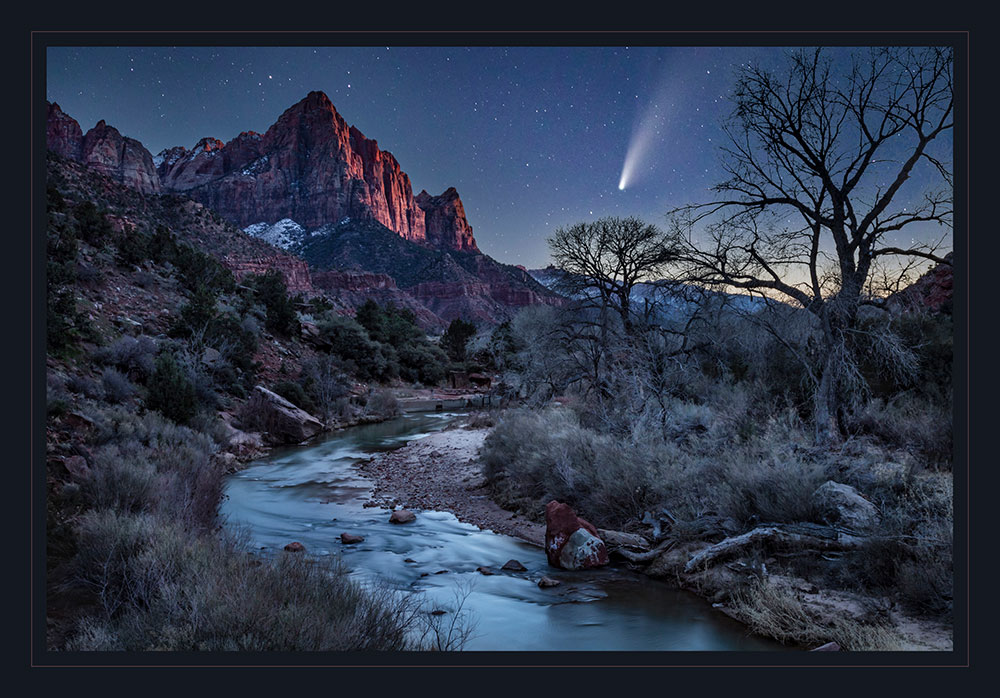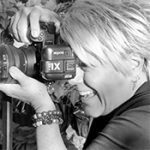
When I was first contacted by Marathon Press about my image, “Celestial Visitor”, I wondered why they didn’t use the full title. Then I remembered that I simplified the title for image competition! I figured if I used the real title, “The Virgin, the Watchman and the Celestial Visitor”, there was little chance that the judges would understand the references and I didn’t want that to be a distraction from the image itself.
I love the “real” title because it has both an allegorical-Grimms-Fairytale-like quality about it and if you are acquainted with this location in Zion National Park, you will understand the references. For those who don’t know, this is the Virgin River and the prominent mountain in the distance is called The Watchman. I think you can figure out what the celestial visitor is.
While I do enter my images in competitions, I have never created an image with competition in mind. Every image I capture starts as a clean slate that is informed by the subject and the circumstance. From my body of work, I sometimes select images that I think might do well in competition and sometimes I select images that I think will challenge the judges. I’m more interested in hearing the comments than winning. I don’t stick to a specific genre. The fact is, I’m always surprised at the competition result. Make no mistake, I enter what I think is very good work but some images are just not right for the climate in a particular competition. I don’t take it personally.
Interestingly, this image was the only one of my images (the other three being another landscape, a wildlife image and an architectural image) that did not make it into the Image Excellence collection. I’m not at all certain why. It has, however, gone on to be named one of the top 101 Landscape Images of 2023 in the International landscape Photographer of the Year competition! Take that, IPC! Hah!
So, about the image…
What I loved about the moment was the quality of light, the coolness of the scene with the last fleeting hints of the setting sun. One of my favorite techniques for night (or near night) photography is to photograph the landscape while there is enough light to see it, then wait around for the sky to get dark enough to see stars and photograph the sky separately. I combine the two in Photoshop, getting the best of both exposures.
If you have experience with this kind of photography, you probably understand just from seeing the image that what you see here would be an impossible situation. If the sun had not set, the sky would be too bright to see stars. If we could see stars, there would be very little detail or color in the landscape. My job was to make it all look believable, not to deceive but to make it look engaging. It was all there but it just took some time to evolve.
As for the composition, it’s both simple and complex and I’m giving Mother nature all of the credit. While the river acts like a leading line, it isn’t where your attention pops to first. Initially you are drawn to the mountain with its bright contrasting color. But then you are almost immediately pulled over to the comet which is the brightest part of the composition.
The largest and most contrasty part of the image is the silhouette of the trees against the brightest part of the sky. That is where your attention goes next until you follow the tree shapes down the right side to the bottom of the image. That’s when the river captures your eyes and pulls you back up to the mountain. All of these ingredients keep the viewer’s attention actively circulating around the image.
Here are the technical bits:
Because I wanted to blur the moving water of the river, the landscape element was a long exposure necessitating the use of a 3-stop neutral density filter. I use the Lee 100 Filter system (square filters).
My exposure data for the landscape element was: 100 ISO, 45mm, f/16, 15 second exposure.
For the sky element, the exposure was: ISO 3200, 105mm, f/4, 8 second exposure. (It wasn’t completely dark.)
My gear: Canon 5DsR body with the 24-105 f/4 L lens and all solidly mounted on a Really Right Stuff tripod with a BH-55 ball head.
I use Lightroom and Photoshop for processing.
To my amazement, “The Virgin, The Watchman and the Celestial Visitor” has garnered a lot of attention. This request from Marathon Press for more info about the image was a nice surprise. I’ve had numerous requests for prints after the announcement of the 2023 Landscape Photographer of the Year Top 101 list. More requests came after the image was published in The Atlantic magazine, announcing the top 101. As I said, I’m pleasantly amazed!
My advice to you is to learn your gear, photograph as often as you can and continue to evolve as artists. You never know when one of your images might strike a chord that resonates with the world. I hope to see you out there making photographic magic!


















